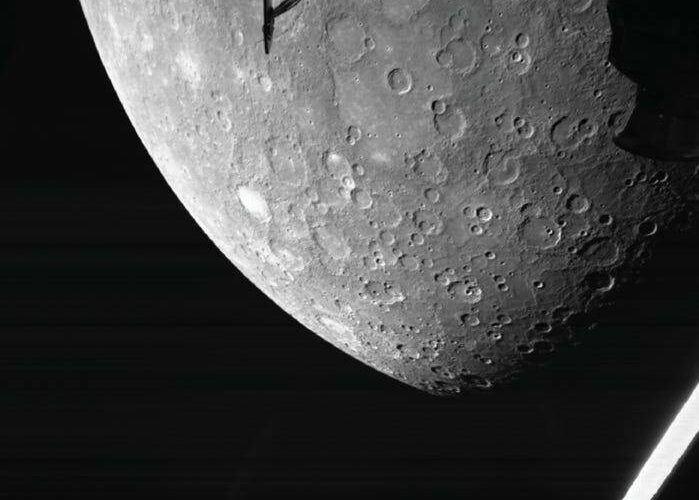- BepiColombo, an European-Japanese spacecraft, went by Mercury interestingly Friday.
- The test radiated back delightfully clear pictures of the planet’s cratered, moon-like surface.
- It’s set to go by Mercury five additional occasions prior to falling into the planet’s circle in 2025.
Mercury is at last back at the center of attention, with a space test zooming past its cratered surface without precedent for six years.
As it went by Mercury on Friday, the BepiColombo shuttle snapped the above photograph from 1,500 miles (2,418 kilometers) away, around 10 minutes subsequent to skimming past the planet. The picture shows antiquated magma fields in Mercury’s northern half of the globe.
This is BepiColombo’s first acceptable gander at its objective planet since it dispatched in 2018. The space apparatus is a joint mission of the European Space Agency (ESA) and Japan Aerospace Exploration Agency (JAXA). It’s on target to fall into space around Mercury in 2025, when it will plan the planet’s surface, investigate its sythesis, and sense its attractive field. Researchers trust this information will uncover the historical backdrop of the nearest planet to the sun.
Above all, BepiColombo needs to swing past Earth, Venus, and Mercury, utilizing the planets’ gravity to pull itself toward its definitive orbital way. The rocket has as of now gone by Earth and Venus. Friday denoted the first of six Mercury flybys.
“The flyby was perfect according to the rocket perspective, and it’s mind blowing to at long last see our objective planet,” Elsa Montagnon, the mission’s shuttle activities supervisor, said in an official statement.
The last time a shuttle flew this near Mercury was in 2015, when NASA’s Messenger test took one final glance at the planet’s holes prior to colliding with its surface.
BepiColombo’s recording shows Mercury blurring into the distance
BepiColombo’s Mercury photographs are excessively point by point such that researchers can distinguish specific pits, named Rudaki, Lemontov, and Calvino.
However, BepiColombo isn’t in any event, utilizing its best focal point yet. The pictures from Friday’s flyby come from its high contrast observing cameras, yet the rocket likewise has a high-goal camera suite that it will send once it at long last accomplishes Mercury circle.
The ESA collected 53 pictures from BepiColombo’s flyby into a video, beneath, to show the planet blurring into the distance as the shuttle zipped away.
At its nearest approach, the space apparatus was only 124 miles (199 kilometers) over Mercury’s surface – however it was in the world farthest from the sun, overwhelmed in evening obscurity.
BepiColombo didn’t get a decent glance at Mercury until it had as of now zoomed past and the planet’s radiant side materialized. The nearest picture in this succession is around 620 miles (1,000 km) from Mercury.
“It was exceptionally invigorating to see BepiColombo’s first pictures of Mercury, and to work out the thing we were seeing,” David Rothery, who drives the ESA’s Mercury Surface and Composition Working Group, said in the delivery. “It has made me much more excited to concentrate on the top quality science information that we ought to get when we are in circle around Mercury, since this is a planet that we truly don’t yet completely comprehend.”
Disclaimer: The views, suggestions, and opinions expressed here are the sole responsibility of the experts. No Unique Analyst journalist was involved in the writing and production of this article.

